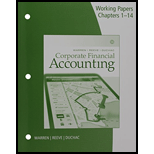
Stock investments: Stock investments are equity securities which claim ownership in the investee company and pay a dividend revenue to the investor company.
Debit and credit rules:
- Debit an increase in asset account, increase in expense account, decrease in liability account, and decrease in
stockholders’ equity accounts. - Credit decrease in asset account, increase in revenue account, increase in liability account, and increase in stockholders’ equity accounts.
To journalize: The stock investment transactions in the books of Industries S
Explanation of Solution
1)
Prepare journal entry for the purchase of 1,000 shares of Company T at $85 per share and a brokerage of $150.
| Date | Account Titles and Explanations | Post. Ref. | Debit ($) | Credit ($) | |
| February | 24 | Investments–Company T Stock | 85,150 | ||
| Cash | 85,150 | ||||
| (To record purchase of shares for cash) | |||||
Table (1)
- Investments–Company T Stock is an asset account. Since stock investments are purchased, asset value increased, and an increase in asset is debited.
- Cash is an asset account. Since cash is paid, asset account decreased, and a decrease in asset is credited.
Working Notes:
Compute amount of cash paid to purchase Company T’s stock.
2)
Prepare journal entry for the purchase of 2,500 shares of Company I at $36 per share and a brokerage of $100.
| Date | Account Titles and Explanations | Post. Ref. | Debit ($) | Credit ($) | |
| March | 16 | Investments–Company I Stock | 90,100 | ||
| Cash | 90,100 | ||||
| (To record purchase of shares for cash) | |||||
Table (2)
- Investments–Company I Stock is an asset account. Since stock investments are purchased, asset value increased, and an increase in asset is debited.
- Cash is an asset account. Since cash is paid, asset account decreased, and a decrease in asset is credited.
Working Notes:
Compute amount of cash paid to purchase Company I’s stock.
3)
Prepare journal entry for sale of 400 shares of Company T at $100, with a brokerage of $75.
| Date | Account Titles and Explanations | Post. Ref. | Debit ($) | Credit ($) | |
| July | 14 | Cash | 39,925 | ||
| Gain on Sale of Investments | 5,865 | ||||
| Investments–Company T Stock | 34,060 | ||||
| (To record sale of shares) | |||||
Table (3)
- Cash is an asset account. Since cash is received, asset account increased, and an increase in asset is debited.
- Gain on Sale of Investments is a revenue account. Since revenues increase equity, equity value is increased, and an increase in equity is credited.
- Investments–Company T Stock is an asset account. Since stock investments are sold, asset value decreased, and a decrease in asset is credited.
Working Notes:
Calculate the realized gain (loss) on sale of stock.
Step 1: Compute cash received from sale proceeds.
Step 2: Compute cost of stock investment sold.
Step 3: Compute realized gain (loss) on sale of stock.
Note: Refer to Steps 1 and 2 for value and computation of cash received and cost of stock investment sold.
4)
Prepare journal entry for sale of 750 shares of Company I at $32.50, with a brokerage of $80.
| Date | Account Titles and Explanations | Post. Ref. | Debit ($) | Credit ($) | |
| August | 12 | Cash | 24,295 | ||
| Loss on Sale of Investments | 2,735 | ||||
| Investments–Company I Stock | 27,030 | ||||
| (To record sale of shares) | |||||
Table (4)
- Cash is an asset account. Since cash is received, asset account increased, and an increase in asset is debited.
- Loss on Sale of Investments is a loss or expense account. Since losses decrease equity, equity value is decreased, and a decrease in equity is debited.
- Investments–Company I Stock is an asset account. Since stock investments are sold, asset value decreased, and a decrease in asset is credited.
Working Notes:
Calculate the realized gain (loss) on sale of stock.
Step 1: Compute cash received from sale proceeds.
Step 2: Compute cost of stock investment sold.
Step 3: Compute realized gain (loss) on sale of stock.
Note: Refer to Steps 1 and 2 for value and computation of cash received and cost of stock investment sold.
5)
Prepare journal entry for the dividend received from Company T for 600 shares.
| Date | Account Titles and Explanations | Post. Ref. | Debit ($) | Credit ($) | |
| October | 31 | Cash | 240 | ||
| Dividend Revenue | 240 | ||||
| (To record receipt of dividend revenue) | |||||
Table (5)
- Cash is an asset account. Since cash is received, asset account increased, and an increase in asset is debited.
- Dividend Revenue is a revenue account. Since revenues increase equity, equity value is increased, and an increase in equity is credited.
Working Notes:
Compute amount of dividend received on Company T’s stock.
Want to see more full solutions like this?
Chapter D Solutions
Working Papers for Warren/Reeve/Duchac's Corporate Financial Accounting, 14th
- Solve questionarrow_forwardA company has the following Accounting information for the year: Sales Revenue: $600,000 ⚫ Cost of Goods Sold: $350,000 • • Operating Expenses: $80,000 Interest Expense: $15,000 Tax Rate: 25% What is the company's earnings before taxes (EBT) for the year?arrow_forwardCan you explain the correct methodology to solve this general accounting problem?arrow_forward
 Financial AccountingAccountingISBN:9781305088436Author:Carl Warren, Jim Reeve, Jonathan DuchacPublisher:Cengage Learning
Financial AccountingAccountingISBN:9781305088436Author:Carl Warren, Jim Reeve, Jonathan DuchacPublisher:Cengage Learning Financial AccountingAccountingISBN:9781337272124Author:Carl Warren, James M. Reeve, Jonathan DuchacPublisher:Cengage Learning
Financial AccountingAccountingISBN:9781337272124Author:Carl Warren, James M. Reeve, Jonathan DuchacPublisher:Cengage Learning Corporate Financial AccountingAccountingISBN:9781305653535Author:Carl Warren, James M. Reeve, Jonathan DuchacPublisher:Cengage Learning
Corporate Financial AccountingAccountingISBN:9781305653535Author:Carl Warren, James M. Reeve, Jonathan DuchacPublisher:Cengage Learning College Accounting, Chapters 1-27AccountingISBN:9781337794756Author:HEINTZ, James A.Publisher:Cengage Learning,
College Accounting, Chapters 1-27AccountingISBN:9781337794756Author:HEINTZ, James A.Publisher:Cengage Learning, Accounting (Text Only)AccountingISBN:9781285743615Author:Carl Warren, James M. Reeve, Jonathan DuchacPublisher:Cengage Learning
Accounting (Text Only)AccountingISBN:9781285743615Author:Carl Warren, James M. Reeve, Jonathan DuchacPublisher:Cengage Learning




